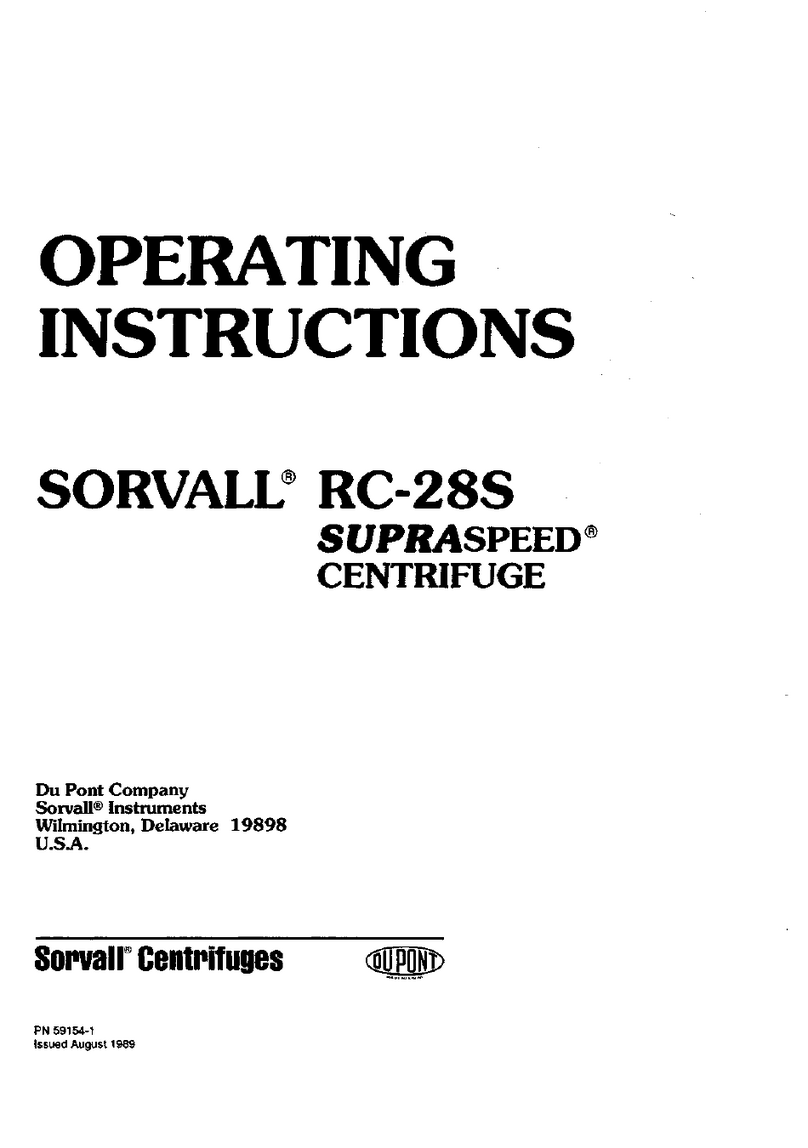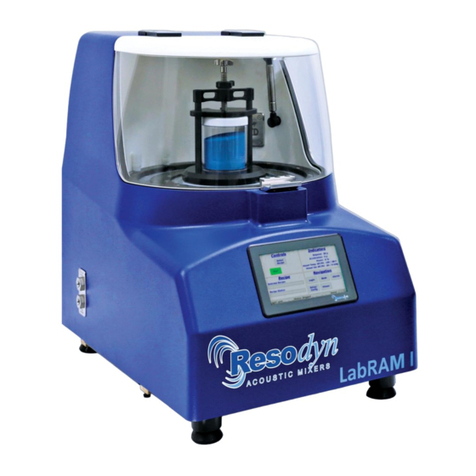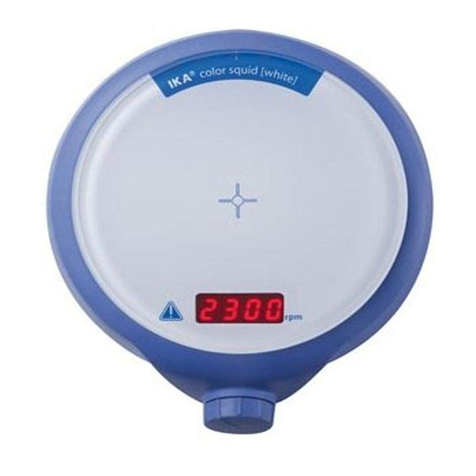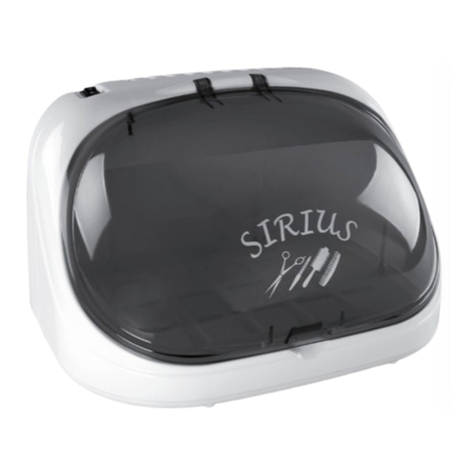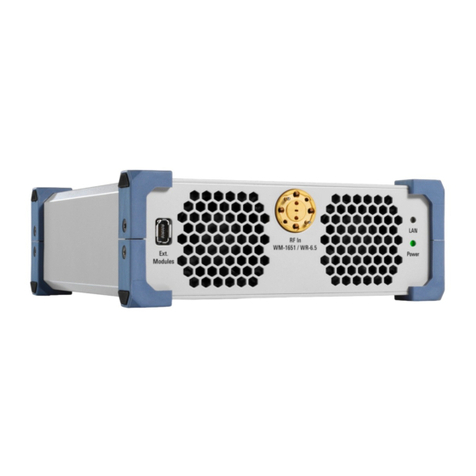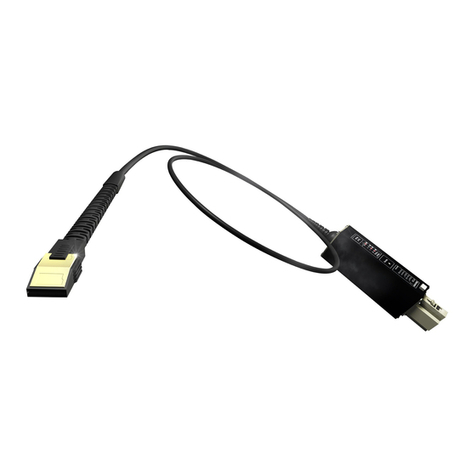Du Pont SORVALL RT6000B User manual

SORVALL Centrifuges
PN 07903-3
Issued July 1993
Du Pont Company
SORVALL®Products
Wilmington, Delaware 19898
U.S.A.
OPERATING
INSTRUCTIONS
SORVALL RT6000B
& T6000B
TABLETOP
CENTRIFUGES

This manual is a guide to the use of the
SORVALL®RT6000B and T6000B
Tabletop Centrifuges
Data herein has been verified and validated and is believed adequate for the intended use
of the centrifuge. Because failure to follow the recommendations set forth in this manual
could produce personal injury or property damage, always follow the recommendations
set forth herein. Du Pont does not guarantee results and assumes no obligation for the
performance of rotors or other products that are not used in accordance with the
instructionsprovided.Thispublicationisnotalicensetooperateunder, nor a recommen-
dation to infringe upon, any process patents.
Publications prior to the Issue Date of this manual may contain data in apparent conflict
with that provided herein. Please consider all data in this manual to be the most current.
NOTES,CAUTIONS,andWARNINGS within the text of this manual are usedtoemphasize
important and critical instructions.
WARNING: AWarninginformstheoperatorofa hazardoranunsafepractice thatcould
result in personal injury, affect the operator’s health, or contaminate the
environment.
CAUTION: A Caution informs the operator of an unsafe practice that could result in
damage of equipment.
NOTE: A Note highlights essential information.
© 1988 by E. I. du Pont de Nemours & Co.
SORVALL®Centrifuges
ii
RT6000B & T6000B

Important Safety Information
Certain potentially dangerous conditions are inherent to the use of all centrifuges. To
ensure safe operation of this centrifuge, anyone using it should be aware of all safe
practices and take all precautions described below and throughout this manual.
WARNING
When using radioactive, toxic, or pathogenic materials, be aware of all characteristics of the
materials and the hazards associated with them in the event leakage occurs during
centrifugation. If leakage does occur, neither the centrifuge nor the rotor can protect you
from particles dispersed in the air. To protect yourself, we recommend additional precautions
be taken to prevent exposure to these materials, e.g., use of controlled ventilation or isolation
areas.
Always be aware of the possibility of contamination when using radioactive, toxic, or
pathogenic materials. Take all necessary precautions and use appropriate decontamination
procedures if exposure occurs.
The use of sealed rotors, buckets and/or sample containers will provide increased protection
from contamination during routine operation. However, these items will not guarantee
contamination protection from accidents resulting in damage to the rotor or buckets. Do not
run hazardous materials in the centrifuge unless placed in a biohazard enclosure and operated
using all appropriate safety precautions.
Never use any material capable of producing flammable or explosive vapors.
Never exceed the maximum rated speed of the installed rotor; to do so can cause rotor failure.
Always reduce (derate) rotor speed as instructed in this manual whenever:
• the rotor speed/temperature combination exceeds the solubility of the gradient material
and causes it to precipitate.
• the compartment load exceeds the maximum allowable compartment load specified. See
Chapter 3, Operation, page 3-6.
Failure to reduce rotor speed under these conditions can cause rotor failure.
CAUTION
Do not run or precool a rotor at the critical speed, as this will have a detrimental effect on
centrifuge component life. See Chapter 3, page 3-3.
Do not operate the centrifuge with a rotor out of balance. To do so can cause damage to the
centrifuge drive assembly.
Do not operate centrifuge without a rotor properly installed: rotor cover must be on and
locked in place, and the rotor locked to the centrifuge drive. See rotor instruction manual.
The centrifuge can be damaged if connected to the wrong voltage. Check the voltage before
plugging the centrifuge into a power source. Du Pont is not responsible for incorrect
installation.
Always maintain the centrifuge in the recommended manner. See Chapter 4, Maintenance.
Safety
SORVALL®Centrifuges
iii

Table of Contents
Page
Safety Information Page . . . . . . . . . . . . . . . . . . . . . . . . . . . . . . . . . . . . . . . . . . iii
Chapter 1. DESCRIPTION
Centrifuge Description . . . . . . . . . . . . . . . . . . . . . . . . . . . . . . . . . . . . . . . . . . . 1-1
Centrifuge Specifications . . . . . . . . . . . . . . . . . . . . . . . . . . . . . . . . . . . . . . . . . 1-1
Rotors . . . . . . . . . . . . . . . . . . . . . . . . . . . . . . . . . . . . . . . . . . . . . . . . . . . . . . . 1-2
Chapter 2. INSTALLATION
Inspection . . . . . . . . . . . . . . . . . . . . . . . . . . . . . . . . . . . . . . . . . . . . . . . . . . . . 2-1
Electrical Requirements . . . . . . . . . . . . . . . . . . . . . . . . . . . . . . . . . . . . . . . . . . 2-1
Installation. . . . . . . . . . . . . . . . . . . . . . . . . . . . . . . . . . . . . . . . . . . . . . . . . . . . 2-2
Chapter 3. OPERATION
Controls and Indicators . . . . . . . . . . . . . . . . . . . . . . . . . . . . . . . . . . . . . . . . . . 3-1
Rotor Considerations . . . . . . . . . . . . . . . . . . . . . . . . . . . . . . . . . . . . . . . . . . . . 3-2
Precooling a Rotor in the RT6000B Centrifuge . . . . . . . . . . . . . . . . . . . . . . . . . 3-3
Running Hazardous Material . . . . . . . . . . . . . . . . . . . . . . . . . . . . . . . . . . . . . . 3-4
Operation . . . . . . . . . . . . . . . . . . . . . . . . . . . . . . . . . . . . . . . . . . . . . . . . . . . . . 3-4
Emergency Sample Recovery . . . . . . . . . . . . . . . . . . . . . . . . . . . . . . . . . . . . . . 3-6
Reducing Speed for Rotor Compartment Loads in Excess
of Design Mass . . . . . . . . . . . . . . . . . . . . . . . . . . . . . . . . . . . . . . . . . . . . . . . 3-6
Chapter 4. MAINTENANCE
Inspection and Cleaning . . . . . . . . . . . . . . . . . . . . . . . . . . . . . . . . . . . . . . . . . . 4-1
REV/MIN x 1000 Indicator Adjustment . . . . . . . . . . . . . . . . . . . . . . . . . . . . . . . . 4-2
Motor Brush Inspection and Replacement . . . . . . . . . . . . . . . . . . . . . . . . . . . . 4-3
RT6000B CHAMBER TEMP°C Indicator Adjustment . . . . . . . . . . . . . . . . . . . . . 4-4
Parts Ordering Information. . . . . . . . . . . . . . . . . . . . . . . . . . . . . . . . . . . . . . . . 4-4
Service Decontamination Policy . . . . . . . . . . . . . . . . . . . . . . . . . . . . . . . . . . . . 4-5
APPENDIX
Warranty
Index
Decontamination Certificates
SORVALL®Centrifuges
Table of Contents
iv

List of Illustrations
Figure Page
3-1. Controls and Indicators . . . . . . . . . . . . . . . . . . . . . . . . . . . . . . . 3-1
3-2. Location of Mechanical Override Loop . . . . . . . . . . . . . . . . . . . . . 3-6
4-1. REV/MIN x 1000 Indicator Adjustment . . . . . . . . . . . . . . . . . . . . . 4-3
4-2. Motor Brush Assembly . . . . . . . . . . . . . . . . . . . . . . . . . . . . . . . . 4-4
4-3. CHAMBER TEMP°C Indicator Adjustment . . . . . . . . . . . . . . . . . . 4-4
List of Tables
Table Page
3-1. Controls and Indicators . . . . . . . . . . . . . . . . . . . . . . . . . . . . . . . 3-1
Table of Contents
SORVALL®Centrifuges
v/vi

A PHOTOGRAPH OF THIS INSTRUMENT WAS NOT TAKEN AND THEREFORE
WILL NOT BE AVAILABLE FOR FIRST PRINTING OF MANUAL
Figure 1-1. SORVALL®RT6000B Refrigerated
Tabletop Centrifuge (T6000B not shown)
SORVALL®Centrifuges
vi

SORVALL®Centrifuges Description
1-1
Chapter 1
DESCRIPTION
This manual provides you with the information you need to install, operate and maintain
your SORVALL®RT6000B and T6000B Tabletop Centrifuges. If you encounter any
problem concerning either operation or maintenance that is not covered in this manual,
please contact our Marketing Technical Group for assistance. In the United States,
telephone toll free (800) 551-2121. Outside the United States, contact your local
distributor or agent for SORVALL®Products.
Centrifuge Description
The RT6000B combines the features of the tabletop centrifuge and those of the larger
refrigerated centrifuge in a compact tabletop instrument. It is similar to other SORVALL®
Tabletop Centrifuges, with an added refrigeration system that consists of an evaporator/
rotor chamber and a low-temperature condensing unit. The system is designed to
maintain temperature within 1°C, while in the operating range of –5°C to +25°C. The
T6000B is a non-refrigerated tabletop centrifuge.
Both the RT6000B and T6000B feature a closed-loop speed control and have a see-
through chamber door that allows rotor calibration and visual inspection of a run in
progress. The chamber door is counterbalanced for easy opening and safe closing. The
lid latch is locked manually by turning the door release knob counterclockwise to the
LOCKED position,thenmechanically aninterlockengageswhen therotorbeginsspinning
to prevent the chamber door from being opened during operation. The gyro-action, self-
centering drive has a diamond hex-shaped drive spindle which assures proper seating of
rotors. Thecentrifugesalsohaveaslow-startfeaturethatslowlyacceleratestherotorfrom
0 to 600rpm.*
Centrifuge Specifications
Maximum Speed** . . . . . . . . . . . . . . . . . . . . . . . . . . . . . 6000 rpm
Operating Temperature
Range (RT6000B only). . . . . . . . . . . . . . . . . . . . . . . –5°C to +25°C
Maximum heat output during
operation . . . . . . . . . . . . . . . . . . . . . . . . . . . . . . . . . . . 6000 Btu per hour (RT6000B)
3000 Btu per hour (T6000B)
** Maximum speed is dependent on rotor and line voltage.
*Speed in revolutions per minute (rpm) is related to angular velocity,
ω
, according to the following:
ω
= (rpm) = (rpm) (0.10472)
Where
ω
= rad/s. All further references in this manual to speed will be designated as rpm.
2π
60)
(
(continued)

SORVALL®Centrifuges
Description
1-2
Centrifuge Specifications (continued)
Electrical Requirements:
RT6000B . . . . . . . . . . . . . . . . . . . . . . . . . . . . . . . . . . . . . . 115 Vac, 60 Hz, 15A, single phase*
220 Vac, 50 Hz, 8A, single phase*
T6000B. . . . . . . . . . . . . . . . . . . . . . . . . . . . . . . . . . . . . . . . 115 Vac, 60 Hz, 8A, single phase
220 Vac, 50 Hz, 4A, single phase
Dimensions:
Width (RT6000B) . . . . . . . . . . . . . . . . . . . . . . . . . . . . . . . . 81 cm (32 inches)
(T6000B) . . . . . . . . . . . . . . . . . . . . . . . . . . . . . . . . . 66 cm (26 inches)
Depth . . . . . . . . . . . . . . . . . . . . . . . . . . . . . . . . . . . . . . . . . 64 cm (25 inches)
Height . . . . . . . . . . . . . . . . . . . . . . . . . . . . . . . . . . . . . . . . . 32 cm (12.5 inches)
Mass (Weight):
RT6000B . . . . . . . . . . . . . . . . . . . . . . . . . . . . . . . . . . . . . . 85 kg (187 lbs)
T6000B. . . . . . . . . . . . . . . . . . . . . . . . . . . . . . . . . . . . . . . . 78 kg (160 lbs)
Rotors
The table below lists the rotors available for the RT6000B and T6000B Centrifuges. For
more information about other rotor accessories and tubes refer to the most current
SORVALL®Rotors, Tubes, Bottles, and Adapters Catalog.
Rotor Specifications
Maximum
Maximum Maximum Relative
Operating Compartment Centrifugal
Rotor Speed (rpm) Mass (grams) Force (RCF)
A-384 Fixed-Angle
Rotor 6000 2714890
A-500 Fixed-Angle 6000 11514960
Rotor
H-1000B Swinging 3200 82022190
Bucket Rotor
A/S-400 Fixed-Angle 4380 9023000
Rotor
1 Includes weight of tube holder, tube or bottle, adapter, and tube contents.
2 Includes weight of adapter, tube or bottle, and tube contents.
*CSA and UL Certified.

SORVALL®Centrifuges Description
1-3
Centrifuge Specifications
Maximum Speed** . . . . . . . . . . . . . . . . . . . . . . . . . . . . . 6000 rpm
Operating Temperature
Range (RT6000B only). . . . . . . . . . . . . . . . . . . . . . . –5°C to +25°C
Maximum heat output during
operation . . . . . . . . . . . . . . . . . . . . . . . . . . . . . . . . . . . 6000 Btu per hour (RT6000B)
3000 Btu per hour (T6000B)
Electrical Requirements:
RT6000B . . . . . . . . . . . . . . . . . . . . . . . . . . . . . . . . . . . . . . 115 Vac, 60 Hz, 15A, single phase*
220 Vac, 50 Hz, 8A, single phase*
T6000B. . . . . . . . . . . . . . . . . . . . . . . . . . . . . . . . . . . . . . . . 115 Vac, 60 Hz, 8A, single phase
220 Vac, 50 Hz, 4A, single phase
Dimensions:
Width (RT6000B) . . . . . . . . . . . . . . . . . . . . . . . . . . . . . . . . 81 cm (32 inches)
(T6000B) . . . . . . . . . . . . . . . . . . . . . . . . . . . . . . . . . 66 cm (26 inches)
Depth . . . . . . . . . . . . . . . . . . . . . . . . . . . . . . . . . . . . . . . . . 64 cm (25 inches)
Height . . . . . . . . . . . . . . . . . . . . . . . . . . . . . . . . . . . . . . . . . 32 cm (12.5 inches)
Mass (Weight):
RT6000B . . . . . . . . . . . . . . . . . . . . . . . . . . . . . . . . . . . . . . 85 kg (187 lbs)
T6000B. . . . . . . . . . . . . . . . . . . . . . . . . . . . . . . . . . . . . . . . 78 kg (160 lbs)
Rotor Specifications
Maximum
Maximum Maximum Relative
Operating Compartment Centrifugal
Rotor Speed (rpm) Mass (grams) Force (RCF)
A-384 Fixed-Angle
Rotor 6000 2714890
A-500 Fixed-Angle 6000 11514960
Rotor
H-1000B Swinging 3200 82022190
Bucket Rotor
A/S-400 Fixed-Angle 4380 9023000
Rotor
RT-6000B

SORVALL®Centrifuges Installation
2-1
Chapter 2
INSTALLATION
This chapter contains instructions to prepare your SORVALL®RT6000B and T6000B for
operation.
Inspection
When you receive your centrifuge, carefully inspect it for any signs of shipping damage.
Ifyoufinddamage,report it immediately to the transportation company and file a damage
claim, then notify Du Pont.
Check the parts received with the centrifuge against the shipping list; if any parts are
missing, contact Du Pont (see back cover).
WARNING
The RT6000B weighs 187 lbs. and the T6000B weighs 160 lbs. Refer to
the unpacking instructions for proper care when lifting and installing the
centrifuge. Failure to use proper lifting techniques can result in possible
damage to the centrifuge and/or personal injury.
CAUTION
Do not lift the centrifuge by the front panel or by the lid. To do so can result
in damage to these parts.
Do not place the RT6000B on its side; any position other than upright can
cause compressor contamination.
Electrical Requirements
The centrifuge has specific power requirements and must be connected to the correct
supply for proper performance. The nameplate on the back of the cabinet specifies one
of the following:
105-125 Vac, 60 Hz, single phase, 15 amps*
210-230 Vac, 50 Hz, single phase, 8 amps*
105-125 Vac, 60 Hz, single phase, 8 amps
210-230 Vac, 50 Hz, single phase, 4 amps
The current draw during acceleration in the T6000B could peak to 15 amps for 60 Hz
centrifuges and 8 amps for 50 Hz centrifuges. Therefore, if the main power source is
*CSA and UL Certified
RT6000B:
T6000B:

SORVALL®Centrifuges
Installation
2-2
protected by fuses rather than circuit breakers, we recommend the use of slow-blow or
time-delay fuses.
CAUTION
If the power cord is connected to the wrong voltage, it can cause damage
to the centrifuge. Check the voltage listed on the nameplate before
plugging the power cord into the power source. Du Pont is not responsible
for incorrect installation.
The power cord has a universal keyed plug that inserts into the receptacle at the back of
the centrifuge. The other end of the power cord has a NEMA5-15P, three-prong molded
cap with a ground pin and parallel blades. The plug will fit Hubbell receptacle No. 5261
for115volt(parallelblades)orreceptacleNo.5561for220volt(tandemblades). Thepower
cord must be attached when the centrifuge is installed.
Installation
To install the centrifuge:
1. Place the centrifuge on a large, sturdy bench or work table that will support its weight
leaving space for sample preparation. Be sure to leave a minimum clearance of
5cm(2 inches) on all sides for pr oper air circulation.
2. Insert the universal keyed end of the power cord into the receptacle at the back of the
centrifuge.
3. Make sure the centrifuge is level. If necessary, place the leveling pads provided under
the corners of the centrifuge.
4. Make sure the POWER switch is set to "0" (off position), then plug the power cord into
a wall receptacle. The centrifuge is now ready for use.

SORVALL®Centrifuges Operation
3-1
Chapter 3
OPERATION
This chapter describes the function of each operating control and indicator and provides
the information necessary to operate your SORVALL®RT6000B and T6000B Centrifuges.
Controls and Indicators
Figure 3-1 shows the location of operating controls and indicators. Table 3-1 lists them
by item number and describes their function.
Figure 3-1. Controls and Indicators
Table 3-1. Controls and Indicators
(keyed to figure 3-1)
Item Name Function
1REV/MIN x 1000 Sets desired run speed. At full counterclockwise
position the speed control is turned off and the rotor
willnotspin. (Thesettingsonthedialindicateactual
rotor speed.)
CAUTION
Continued operation of the centrifuge be-
low600rpmmaydamagethespeedcontrol.
(continued)
dial

Operation SORVALL®Centrifuges
3-2
Table 3-1. Controls and Indicators (continued)
(keyed to figure 3-1)
Item Name Function
2REV/MIN x 1000 Indicates actual rotor speed from 0 to 6000 rpm
±100 rpm.
3OPEN light* Lights at the end of the run to indicate that the door
may be opened.
4FAULT light* Lights when a rotor imbalance occurs or when a
drive belt malfunction occurs. Centrifuge will not
restart until problem has been corrected.
4FAULT light* Lights when a rotor imbalance occurs, when cham-
ber over or under temperature occurs, or when a
drive belt malfunction occurs. The centrifuge will
not restart until problem has been corrected.
5CHAMBER TEMP°C Indicatesactualchambertemperaturefrom-20°Cto
+40°C.
6CHAMBER TEMP°C Sets desired chamber temperature from -20°C to
+40°C.
7TIME dial Sets length of run time up to 30 minutes (or 35
minuteson50Hzinstruments). At∞,setsindefinite
runtime. TheTIME dialactsasastartswitchtobegin
centrifuge run.
8 Door release knob When the knob is turned to OPEN it will release the
door latches; when knob is turned to LOCKED it
engages the door latches.
9BRAKE switch When set to "", the centrifuge brakes to approxi-
mately 200 rpm at end of run then coasts to a stop.
When set to " ", the centrifuge coasts to a stop
without braking.
10 POWER switch The power switch is an on/off toggle switch that,
when set to "I" applies power to the centrifuge.
Rotor Considerations
a. Rotor Temperature
Any type of centrifugation creates an increase in rotor temperature. The increase in
temperature is caused by many variables including ambient temperature, rotor speed,
length of the run, and the type of rotor.
*These messages are backlit, meaning that each message lights only when the condition that it represents exists.
(T6000B)
(RT6000B)
indicator
(RT6000B only)
dial(RT6000Bonly)
indicator

SORVALL®Centrifuges Operation
3-3
Air flow through the T6000B centrifuge is designed to minimize increase in rotor
temperature. Air enters through an opening in the center of the lid and exits through the
exhaust duct at the top of the rotor chamber.
WARNING
Blocking the air flow entering and/or exiting the T6000B rotor chamber
will cause an increase in the temperature within the rotor chamber. The
temperature increase can temporarily distort the non-metal surfaces
allowing particles to exit the rotor chamber resulting in personal injury and/
or centrifuge damage should tube breakage or rotor failure occur.
When running temperature-sensitive material we recommend that you do a trial run.
b. Rotor Installation, Loading and Balancing
Refer to the rotor instruction manual for loading and balancing procedures as well as
information regarding the selection and use of tubes, bottles, and adapters.
WARNING
When loading the rotor, be sure not to exceed the maximum compartment
mass of the rotor (see Table 1-1 or the individual rotor instruction manual).
If maximum compartment mass is exceeded, maximum rotor speed must be
lowered as described on page 3-6, Reducing Speed for Rotor Compartment
Loads in Excess of Design Mass. Failure to do so can cause rotor failure
which could result in personal injury and/or centrifuge damage.
CAUTION
Do not operate the centrifuge without a rotor installed and properly
balanced. Also, when installing a rotor carefully place it on the centrifuge
drive spindle. The drive can be damaged if rotors are dropped onto it.
Precooling a Rotor in the RT6000B Centrifuge
For operation at temperatures other than ambient, the rotor and rotor chamber should
be precooled before the run using either of the precooling methods described.
a. Precooling a Rotor in the Centrifuge
1. Follow steps 1 through 6 of the operating instructions (pages 3-4 and 3-5).
2. Set the REV/MIN x 1000 dial to 1500 rpm.
The length of time it will take to precool a rotor will vary depending on the temperature
selected, rotor weight, and rotor material.

Operation SORVALL®Centrifuges
3-4
b. Precooling the Centrifuge Chamber Only
If the rotor has been precooled outside of the chamber (e.g., in a refrigerator or cold room),
the chamber should be precooled before the run.
1. Withthe chamber door closed, set theCHAMBER TEMP°C dialtothetemperature
desired.
2. Whenthechamberiscooledtothepropertemperature,installtheprecooledrotor
and begin the centrifuge run.
NOTE
To expedite cooling of the centrifuge chamber, run an empty rotor at
1500 rpm.
Running Hazardous Material
Because neither centrifuge chamber of the RT6000B or T6000B are designed for
biocontainment, some vapors or aerosols released from uncapped, leaking or broken
tubes may leak from the chamber during operation. Once a run is completed and the
chamber door is opened, the vapors or aerosols which have concentrated in the chamber
will be released into the laboratory area. For this reason, when materials which are
pathogenic, toxic, or otherwise hazardous in nature are to be run, the centrifuge should
be placed in a biohazard safety enclosure and operated using all appropriate safety
precautions. Observe the WARNING found on the Safety Information Page.
Useappropriatedecontaminationproceduresshouldexposure toanyhazardous material
occur. See Chapter 4 for the procedure to follow if a centrifuge or rotor that has been used
with a hazardous material must be returned to our service facilities for repair.
Operation
To perform the run:
1. Set the POWER switch to "I", and turn the TIME dial off. (The fan will turn on and
continue to operate whenever the POWER switch is in the on position).
NOTES
RT6000B Centrifuges ONLY:
The FAULT light may come on when the power is turned on with the door
closed. The light will go off when the door is opened.
It is recommended that the chamber door be kept closed when the
centrifuge is not in use to prevent condensation from forming in the rotor
chamber.

SORVALL®Centrifuges Operation
3-5
2. When the OPEN light comes on, turn the door release knob to the OPEN position, and
lift the chamber door up.
3. Install the rotor on the drive shaft and close the door. Turn the door release knob to
the LOCKED position (the door latches will engage).
CAUTION
Be sure the rotor is properly balanced and seated on the drive spindle. See
rotor instruction manual.
4. RT6000B only: Set the CHAMBER TEMP°C dial to the run temperature desired.
5. Set the BRAKE switch to " " if braking is desired.
6. Set the TIME dial to the run time desired.
7. Set the REV/MIN x 1000 dial to the desired run speed.
NOTE
The settings on the REV/MIN x 1000 dial indicate actual rotor speed. Verify
the rotor speed by checking the REV/MIN x 1000 indicator.
A zero speed switch is incorporated in the REV/MIN x 1000 dial. This switch
prevents rotation of the rotor if the door is locked and the timer is on.
At the end of the run remove the rotor as described below.
WARNING
Always check that the rotor has stopped spinning before opening the
chamber door. Do not open the door while the rotor is still in motion; to
do so can result in possible injury.
To remove the rotor:
1. Leave the POWER switch set to "I".
2. If the TIME dial is set to ∞, turn it off.
3. When the OPEN light comes on, turn the door release knob to OPEN position and lift
the chamber door up.
4. Remove the rotor, close the chamber door, and set the POWER switch to "0".

Operation SORVALL®Centrifuges
3-6
Emergency Sample Recovery
Ifthemainpowershutsoffbecauseofapowerfailureorsystemmalfunctionwhiletherotor
is spinning, the chamber door will not open. A mechanical override is provided to allow
sample recovery in the case of an emergency.
WARNING
This procedure is included for emergency sample recovery only and
should never be used for any purpose other than those explained in this
section.
When the main power shuts off, the brake will not operate. Wait until the
rotor stops spinning before using the mechanical override.
The mechanical override loop is located under the right, front corner of the centrifuge as
showninfigure 3-2. To operate the override, insert a screwdriver or similar object into the
metal loop and pull down. Turn the door release knob to the OPEN position and lift the
chamber door up.
Figure 3-2. Location of Mechanical Override Loop
NOTE
Leave a clearance area around the lower right corner of the centrifuge to
prevent obstruction of the mechanical override.
Reducing Speed for Rotor Compartment Loads
in Excess of Design Mass
There is a maximum allowable compartment mass established for each centrifuge rotor.

SORVALL®Centrifuges Operation
3-7
To prevent rotor failure, the total contents of any compartment, including specimen,
tubes, cover, and adapters (if used), must not exceed the figure given on page 1-2 unless
rotor speed is reduced proportionately.
Strict adherence to the maximum allowable compartment mass or reduced speed is
required to prevent rotor failure. Observe WARNING on the Safety Information Page
in front of this manual.
The rotor speed is reduced in proportion to the square of the ratio for the maximum
allowable compartment mass to the actual compartment mass (including specimen,
tubes, covers, and adapters). If the compartment mass is more than that specified for the
rotor, the reduced speed can be determined by using the formula given below.
Reduced Rotor Speed = Maximum Rotor Speed x
3-7/3-8
√Maximum Compartment Mass
Actual Compartment Mass

SORVALL®Centrifuges Maintenance
4-1
Chapter 4
MAINTENANCE
This chapter describes routine maintenance procedures that you should perform on a
regular basis. As the user, it is your responsibility to make certain that these procedures
are followed when necessary. Also, to keep your centrifuge in good working condition and
ensureaccuratetestresults,we recommend that,inadditiontothese routineprocedures,
you have the speed control, timer, rotor imbalance detector and temperature control
checked periodically by a Du Pont Service Representative or other qualified service
personnel because occasionally, these controls may need to be recalibrated. If further
service is needed, contact your local representative for SORVALL®Products.
WARNING
Because of the high voltages in this centrifuge, only personnel trained in
electronics should test or repair the electrical circuits.
If hazardous materials have been processed in the centrifuge, take all
necessary precautions when cleaning or servicing the centrifuge to avoid
personal exposure to contamination.
Inspection and Cleaning
a. Inspection
Inspect the centrifuge each week for signs of wear, encrusted biological deposits, and
general cleanliness. Follow the cleaning procedures described below when necessary.
b. Cleaning
Rotor Chamber
The rotor chamber should be kept clean and wiped dry. Wash the rotor chamber with
amild,nonalkalinedishwashingliquid,thenrinseanddrywithasoftabsorbentcloth.
Use 70% ethanol to disinfect the rotor chamber or a 2% glutaraldehyde solution to
sterilize it. For general radioactive decontamination, use a solution of equal parts of
70% ethanol, 10% SDS, and water. Follow this with ethanol rinses then deionized
water rinses. Dry with a soft absorbent cloth. Dispose of all wash solutions in proper
radioactive waste containers. Read the CAUTION on the next page.

Maintenance SORVALL®Centrifuges
4-2
CAUTION
Chlorides are extremely harmful to aluminum alloy rotors and can cause
stress corrosion cracking. Therefore, if chlorides are used to disinfect the
chamber, be sure to rinse the chamber thoroughly with water to remove all
of the chloride cleanser.
Periodically defrost the rotor chamber of the RT6000B to maintain efficient cooling.
The chamber can be defrosted by either leaving the door open with the power off until
the frost melts, or by running a rotor for approximately five minutes at 40°C. When
the chamber has been completely defrosted, wipe the chamber dry.
Drive Spindle
Before each run, wipe the spindle with a soft cloth before a rotor is installed to reduce
the chance of the rotor sticking to the spindle. To keep the surface of the spindle
smooth, polish occasionally with #400 Emery cloth. Always wipe the spindle clean
after polishing.
Cabinet
Clean the enameled cabinet panels with a household wax cleaner. Use a mild,
nonalkaline detergent and water to clean the centrifuge.
Chamber Door
Clean the chamber door with a soft, wet cloth and soapy water. Avoid using abrasive
materials (for example, dry papertowels) and organic solvents (for example, acetone)
on the dry surface.
Condenser Fins
To maintain the efficiency of the RT6000B refrigeration system, keep the condenser
fins (located in the front of the centrifuge) free of dirt and dust. Clean the fins with
a brush or vacuum cleaner at one to three month intervals.
c. FAULT System Check
To check the function of the FAULT system, move the drive spindle back and forth to
simulate a rotor imbalance. This should cause the FAULT indicator to light.
REV/MIN x 1000 Indicator Adjustment (figure 4-1)
WiththePOWER switchset to"0",use a screwdriver andadjustthezero adjustment screw
until the pointer reads 0.
This manual suits for next models
1
Table of contents
Other Du Pont Laboratory Equipment manuals
Popular Laboratory Equipment manuals by other brands
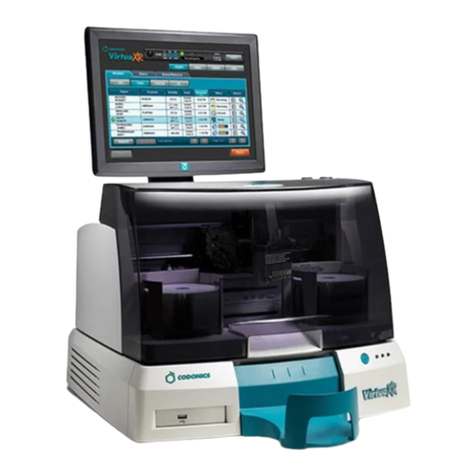
Codonics
Codonics Virtua Ink Cartridge Technical brief
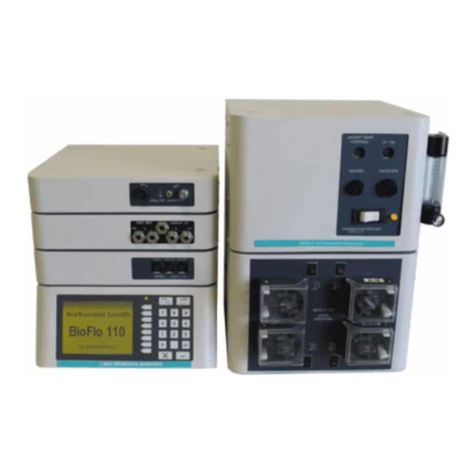
NEW BRUNSWICK SCIENTIFIC
NEW BRUNSWICK SCIENTIFIC BioFlo 110 Guide to operations
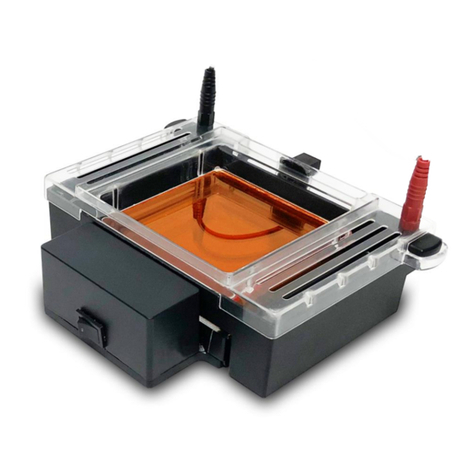
Benchmark Scientific
Benchmark Scientific Accuris MyGel InstaView operating manual

Agilent Technologies
Agilent Technologies 6850 Series Service information
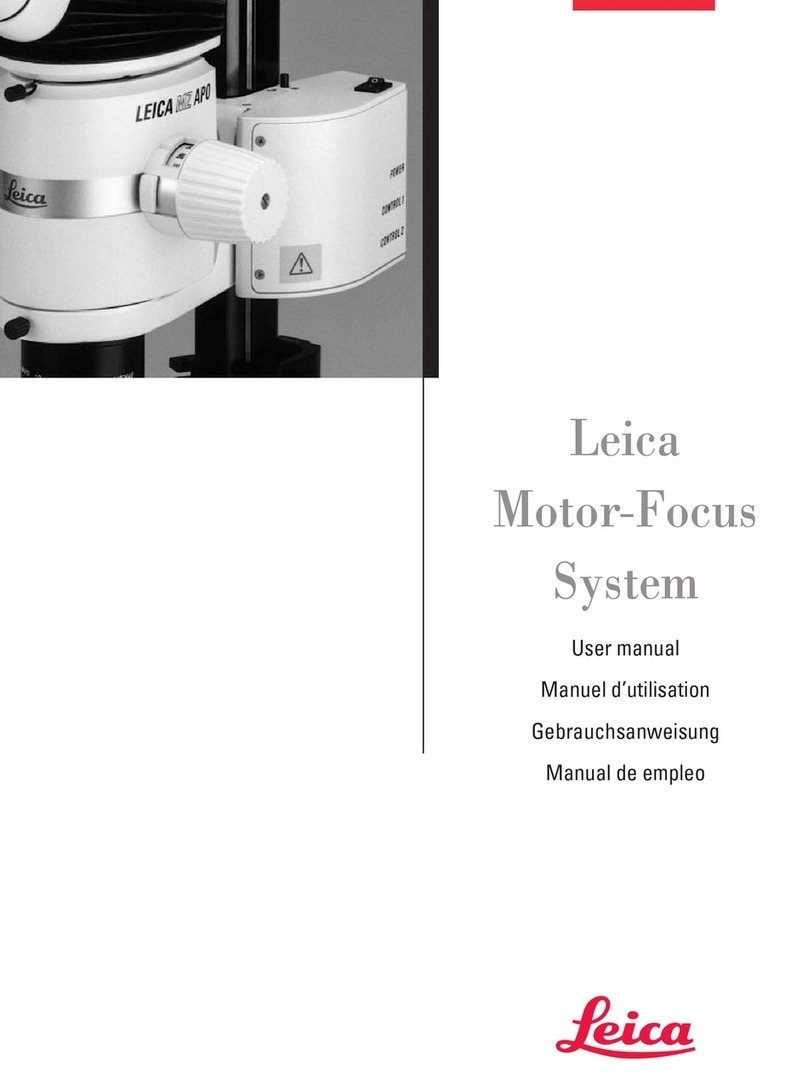
Leica
Leica MST31 user manual
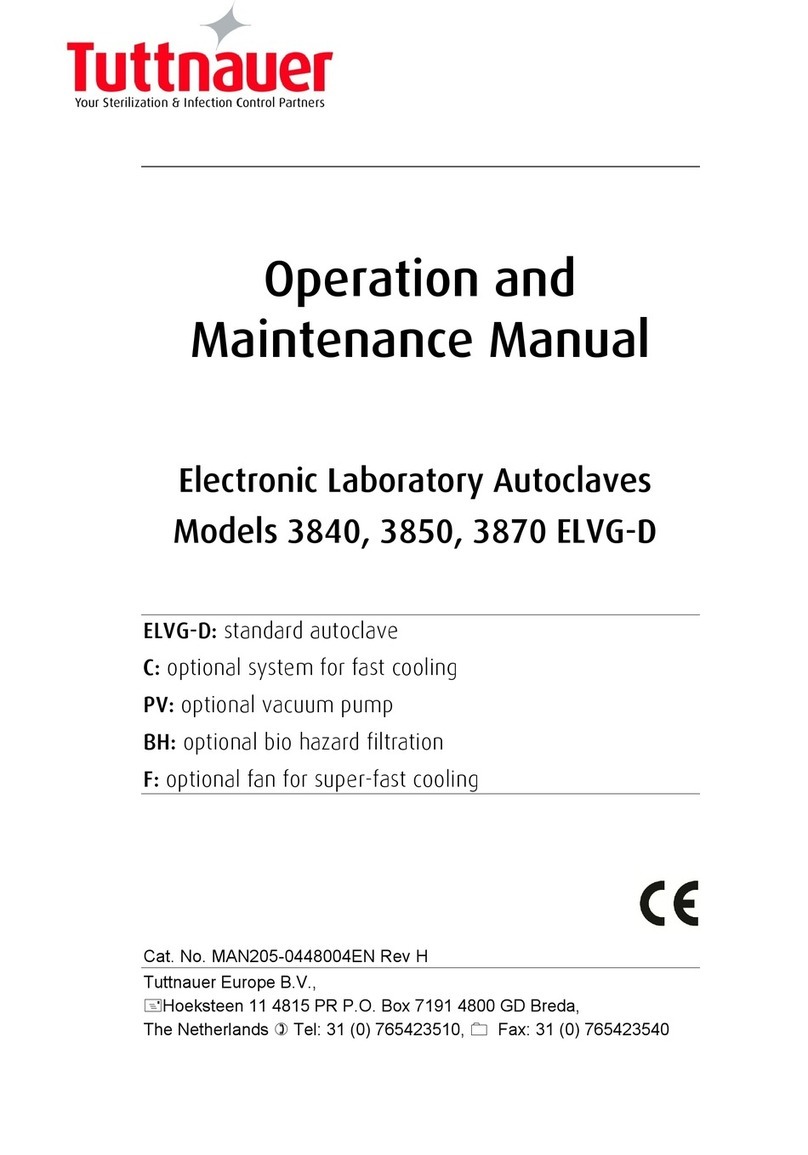
Tuttnauer
Tuttnauer 3840 ELVG-D Operation and maintenance manual
